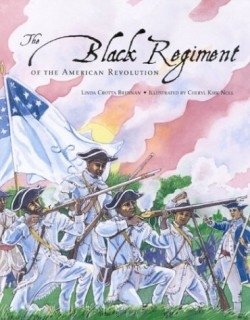It looks like you've stumbled upon a page meant to be read by our code instead of viewed directly. You're probably looking for this page.
The Black Regiment of the American Revolution
The role of African-Americans in United States? military history is not well known. Stories about the heroic Tuskegee Airmen, who fought in World War II, are becoming more familiar, as are others about the blacks who fought in the Civil War. The picture becomes more complete with this dramatic account of a black regiment, mostly composed of slaves, who bravely held back the British and Hessians during a major battle of the American Revolutionary War.
This unusual regiment was organized because exhausted white enlisted soldiers from Rhode Island, a tiny New England slave state, were returning home, and an effective force was needed to replace them. General James Varnum approached the state legislature about raising an all-black regiment. This would mean that blacks could fight, not just serve as cooks or waiters in the white army.
Although owners resisted the idea of arming their slaves, the legislature passed a law allowing “every able-bodied Negro, mulatto, or Indian man-slave” to enlist. Owners would be reimbursed, and the enlisted slaves would be freed. Within four months the law was rescinded, but there were already 200 enlistees, most of them former slaves, in the new regiment.
The well-drilled, smartly dressed regiment proved its mettle, even after the French allies retreated and the white militia was pulled back by the governor to protect other parts of the mainland. In a fierce battle against crack Hessian fighters, the Black Regiment drove back assaults three times. Later the black soldiers joined with others to defeat the British at Yorktown, Virginia.
The award-winning author, a Rhode Island resident, has previously published a children’s nonfiction book about North Carolina, as well as the picture books Flannel Kisses and Marshmallow Kisses. Here, she weaves the stories of several individual soldiers through her detailed historical narrative. She explains that victory did not mean happy personal endings for many of the black soldiers. Those who survived often had to work at low-paying jobs to pay for family members’ freedom.
The illustrator has created art for more than twenty children’s books about American history, including Revolutionary War Days and Civil War Days, as well as books about other cultures. The picture-book format of this volume allows space for her handsome illustrations, plus maps and materials from the Library of Congress and the Rhode Island Historical Society.
The book is a refreshingly straightforward history; it is not dumbed down for middle readers in its vocabulary or content. A glossary, suggested reading, and Web sites to visit will lead youngsters to even more knowledge. This detailed resource book is not just for Rhode Island readers, but for anyone who wants to learn more about the role of African-Americans in this nation’s history.
Reviewed by
Linda Salisbury
Disclosure: This article is not an endorsement, but a review. The publisher of this book provided free copies of the book to have their book reviewed by a professional reviewer. No fee was paid by the publisher for this review. Foreword Reviews only recommends books that we love. Foreword Magazine, Inc. is disclosing this in accordance with the Federal Trade Commission’s 16 CFR, Part 255.
